IPOs & Share Offers
Browse our current and recent work on capital raisings and initial public offers across all industries, sectors and varying sizes.
.webp)
What is an IPO or Share Offer?
An offering refers to when a company issues or sells a security. The most common form is an initial public offering (IPO), when a company’s stock is made available for purchase by the public. It can also be used in the context of an already listed company seeking to raise equity capital by offering new shares to a number of selected investors, referred to as a placement offer.
Receiving a Prospectus

Receiving a prospectus
To initiate an IPO for equity capital, a company must create a detailed prospectus and submit it to the Australian Securities and Investments Commission (ASIC). This document should encompass essential information for investors to make informed judgments about investing in the company. The prospectus ensures transparency and regulatory compliance, fostering a conducive environment for IPOs.

Taking applications
The company selects recipients for its shares, which may include customers, institutional investors, or the general public. To apply for shares, eligible individuals can complete the prospectus application form or use their participating broker in the IPO.

Share allocations
After receiving applications, the company and its advisers will confirm allocations. An oversubscribed IPO occurs when applications exceed available shares. This may result in a 'scale back,' where your application could receive fewer, or no shares than initially requested.

Company listing
After making allocations and receiving application funds, the new shares are officially 'listed' on the share market. Post-listing, the company's shares become tradable, subject to market dynamics, with prices influenced by supply, demand, and market conditions.

Post listing rights issues
A 'rights issue' occurs when a listed company aims to raise extra capital by providing new shares to current shareholders. These additional shares are offered based on a predetermined ratio, like one for every ten held. Typically, rights issues come with a discount on the current market price. Participation is voluntary for existing shareholders.

News & insights
The Australian economy, challenge and opportunity
Today we want to talk about the unusual group of challenges which the Australian economy now faces. We will then move on to look at some remarkable opportunities.
Last year 2024, the US economy grew by 2.2%. We think it will grow in 2025 by 1.8%. This modest slowing of growth is occurring as the Fed Reserve achieves a soft landing in the US economy.
We expect that the Fed Reserve having achieved that soft landing, will undertake a series of rate cuts, with the first beginning in the meeting of 10 December this year. We expect a single rate cut of 25 basis points of that meeting with a further 25 basis points at the next meeting in the new year. This will bring down the Fed Funds rate to our estimate of neutral.
The Fed might reasonably be expected to cut rates further to provide a genuine stimulus for recovery in the US economy later in the year. We expect that after growth of 1.8% in 2025, growth should accelerate to 2.2% in 2026.
Australia is in an international environment where growth in 2026 is expected go be better than growth in 2025. The Australian economy is recovering within this positive international outlook. After 1.3% growth in 2024, we expect the Australian economy to grow by 2.1% in 2025. This should then be followed by an improvement in growth to 2.3% in 2026.
The problem Australia has, in the short term, is a rebound in inflation. After 2.4% inflation in 2024, it is likely that CPI headline inflation will reach 3.8% in 2025. Indeed it already reached this number for the year to October 2025. Depending on government action, we think inflation might ease to a headline level in 2026 of 3.0%.
Chart 1: Electricity Rebate Price Chart – October monthly CPI

In this chart above, the blue line represents the actual cost of generating electricity in Australia over the period from June 2023 to October 2025. The black line below it is the actual retail cost to Australians after Fed govt subsidies have been provided to reduce the retail price. Since June 2023, the Fed govt has provided five Energy Bill Relief Fund (EBRF) rebates. These are provided by the Commonwealth to individual States to subsidise and reduce the retail price in their own State.
The black line represents the series which is used for electricity in the Australian consumer price index (CPI). Our observation is that rises and falls in this measure also affect the broader CPI after a lag of two quarters. This is important because we can see that between June 2024 and October 2024, this measure of electricity prices fell from 107.4 in June to 69.9 in October 2024.
Our belief it was this decline in subsidised electricity prices which allowed the decline in the CPI in Australia in the first half of 2025. This in turn generated an environment for the RBA to cut rates.
After reaching its low of 69.5 in 2024, the retail index rose gradually as the subsidies from the Fed govt declined. This led this component of the CPI to rise to 114.3 in June 2025. This was a rise of 44.8%. It is this rise which months later is feeding its way into the Australian CPI and causing a sharp move up in the CPI as we move towards the end of calendar 2025.
By the time of the October CPI, this had led that index to rise at a rate of 3.8% from the level the year before. What happens in the future to this component of the CPI is entirely dependent upon govt policy. A previous statement by the Treasurer is that no more subsidies will be provided by the end of this year. We will have to wait and see what emerges in the budget for 2026.
Our major concern is not with the series including government rebates. Our major concern is with the cost of generating electricity, excluding the electricity rebates. We now turn our attention to light blue line. This shows that the cost of generating electricity rose from an index level of 100 in June 2023 to 121.9 in October 2025. This is a rise of 21.9% in two years.
In this period the Australian economy is undertaking an energy transition to renewable generating system. This means that an increasing amount of electricity is being generated by solar panels and wind mills. Our understanding is that at the time of writing, this renewable component of electricity has now risen to 36% of total electricity output. We are told that these forms of renewable energy are the cheapest form of generation. Why therefore has the price made such a significant rise?
It is true that solar panels and windmills will generate very cheap energy for periods of time during the day. The problem however is opposed to the variable generation of energy for parts of the day, consumers demand that electricity be available 100% of the day. This ability is provided by forms of energy which stabilise or “firm” generation so that power will be available 100% of the day. At this time, the only form of energy which can currently provide this stability at scale comes from gas peaking plants. This means that natural gas is the form of energy which provides the last marginal unit of production which makes electricity available. Economists know that for a market to clear and a product to be available 100% of the day, then the price of the good must be equal to the last margin unit of production. In this case that last margin of production is provided by natural gas. So the pricing of renewal energy is governed by the pricing of natural gas.
This means that renewable energy will be very cheap if that natural gas is available at a cheap price. This for example was the case in Germany before the war in the Ukraine. Up until that time, the last unit of renewable energy was being provided by very cheap natural gas.
What then happened was that that very cheap Russian natural gas was replaced by more expensive Norwegian gas and even more expensive gas provided by American LNG.
In the long term, it is the price of natural gas which is determining the increasing cost of Australian renewable energy. In the short term, anecdotal evidence suggests the rise in electricity price in eastern Australia followed the closure of the Liddell Power Station near Muswellbrook in 2023. The station had four 500Mw generating units with the last taken off line in April 2023. At the time of closure, Liddle was supplying 10% of NSW electricity demand. This closely tallies with the escalation of electricity generation cost in mid 2023. This suggests that the problem is not whether renewable energy is or is not preferable to coal power electricity. The issue is that there in not enough electricity currently being generated. It is this shortage of electricity which has generated an increase in price. We note that the electricity price in the chart above Excluding Government Electricity Rebates, increases in price immediately after the time when Liddell power station is withdrawn from service.
The result of this inflation influence from electricity prices is that the Australian cash rate will rise during calendar 2025. Our model of the cash rate currently suggests two rate hikes each of 25 basis points in the first half of 2026. This will take the Australian cash rate to 4.1%.
At the same time that the Australian cash rate is rising, the US Fed Funds rate should be falling. Our model of the Fed Funds rate currently suggests an equilibrium level of 3.32%. This suggests two rate cuts, the first in December 2025 and the second in the first quarter of 2026.
The fact that the Fed Funds rate should fall at the same time as the Australian cash rate should rise, immediately suggests a rise in the Australian dollar. We expect the $A/$US exchange rate to rise to US71cents by the middle of 2026.
The falling Fed Funds rate should of course put downward pressure on the US dollar. This will in turn allow a revival of commodity prices. We expect a broad based recovery in commodity prices, beginning with soft commodity prices. The fall in the $US should generate a significant recovery in the price of wheat, corn and cotton. Following the recovery in soft commodities, we should see the beginning of recovery in oil and gas. This recovery in oil and gas is in spite of the very pessimistic outlook that is currently gripping the energy market. This broad recovery in commodities should generate a healthy recovery in Australian cyclical stocks.
Chart 2: Seasonality ASX200 versus S&P500

Our model for the S&P500 and the ASX200 both show that both these markets are overbought. This means that they are both significantly higher than the fair value presented by our model. This level of over-valuation is not unusual at this time of the year. Our chart above shows average seasonal variation in both the S&P500 and the ASX200. Both rally to near term peaks in November and December. These seasonal peaks are then followed by a correction continuing up until March/April.
We think this kind of seasonal correction is likely to follow in coming months. The correction should be mostly completed by the end of March 2026. The correction on a seasonal basis because at the end of the European financial year in March, investment institutions tend to withdraw from the market ahead of their end of financial year balanced dates.
In summary, our view is that both the Australian economy and the US economy, still share an outlook for healthy growth. A fall in the $US as we go into the early months of calendar 2026, should have the result of a broad recovery in commodity prices. This should generate an earnings recovery for Australian stocks.
In the very short term, we think both the US and Australian markets are overbought. Still, if we are patient, by the time we get to the end of the first quarter, a strong outlook of market recovery should then arise
FAQs
What is the Australian GDP forecast for 2026?
We expect GDP growth of around 2.1% in 2025, improving to about 2.3% in 2026 as global conditions and domestic demand firm.
Why is inflation rising in Australia in 2025?
Retail electricity prices rebounded as subsidies eased and generation costs climbed, feeding into CPI with a lag. Tight supply conditions have amplified the effect.
How will interest rates change into 2026?
Our base case is two RBA hikes (2 × 25 bps) in the first half of 2026, while the Fed trims its policy rate. The divergence favours a stronger AUD.
What role does renewable energy play in electricity prices?
Renewables lower average costs when firming is efficient and gas is cheap. When firming costs rise or gas supply tightens, wholesale prices increase.
Is the Australian economy outlook 2026 positive for markets?
After a seasonal correction into March/April 2026, a softer USD and recovering commodities should support Australian cyclicals and broader market performance.
Superannuation Changes in 2026: What Div296 and PayDay Super Mean for Your Wealth
Key Takeaways
- Div296 overhaul introduces tiered tax rates for super balances above $3M and $10M, starting 1 July 2026.
- PayDay Superannuation law requires employers to pay Super Guarantee within 7 business days of wages.
- Economic outlook for 2026 shows steady growth and opportunities for investors.
- SMSF members must take extra care to meet annual minimum payment requirements to avoid losing the pension exemption.
- Age pensioners have a bit more flexibility without earned income affecting their pension benefits.
Introduction
More superannuation reforms are coming in 2026, which will impact high-balance super holders and employers. The government has revised Div296 policy and the new PayDay Superannuation legislation aims to improve fairness and compliance in Australia’s retirement system. Combined with a shifting economic outlook, these changes make it critical to review your strategy now.
This guide explains what’s changing, why it matters, and how you can prepare.
Div296 Explained: New Rules for High-Balance Super Accounts
From 1 July 2026, the government will implement a tiered tax system for large super balances if legislation is implemented:
What this means for you:
- If your Total Super Balance (TSB) exceeds $3M, a portion of your earnings will attract higher tax.
- SMSF members and defined benefit interests are included.
- The ATO will calculate liabilities, but funds must report realised earnings.
Action steps:
- Clients should hold off taking any action until we know more. There are still many details yet to be clarified with the amended Div296 policy so we ask clients to continue to be patient.. Continue to speak to your adviser, who will keep you updated when further details are released by the government.
PayDay Superannuation: On-Time Employer Contributions Become Law
The Treasury Laws Amendment (PayDay Superannuation) Bill 2025 introduces a major compliance shift:
- Start date: 1 July 2026.
- New rule: Employers must pay Super Guarantee within 7 business days of paying wages (Qualifying Earnings).
- Penalties: Increased fines for late payments.
- Impact: Small businesses may face challenges adapting to real-time reporting. The change in timing of SGC payments in the first year may result in employees exceeding their concessional contribution cap if they are also salary sacrificing into super.
Why it matters:
This change aims to reduce unpaid super and improve retirement outcomes. Employers should ensure they understand this new law by utilising available education tools and resources that are available. Payroll systems will need to be updated and staff educated prior to 1 July commencement date.
Economic Outlook for 2026: What Investors Should Know
Australia’s economy is forecast to improve to 2.3% in 2026, with inflation easing to 3.0%. Key trends include:
- AUD strength: Expected to rise to US70 cents in 2026.
- Commodity recovery: Wheat, corn, and soybeans undervalued, leading to opportunities for agribusiness investors.
- Global stability: Growth is healthy but not spectacular.
Investor takeaway:
Diversification across all asset classes and sectors remains critical.
Practical Steps to Prepare
For Individuals
- Review super contributions strategies to ensure caps won’t be breached, and ensure annual minimum pension payments are made.
- Understand Work Bonus rules if you’re a pensioner and partake casual work.
For SMSF Trustees
- Ensure compliance with updated ATO rulings on income streams and minimum payment standards.
For Employers
- Seek advice on what upgrades need to occur to your payroll systems in preparation for PayDay Super compliance.
Conclusion
Once again, 2026 brings more superannuation changes. Whether you’re an investor, employer, or retiree, proactive planning is essential to protect and grow your wealth.
Ready to prepare?
Speak to a Morgans adviser today for tailored strategies on superannuation, SMSF compliance, and investment planning.
Morgans clients receive exclusive insights such as access to our latest Your Wealth publication.
Contact us today to begin your journey with Morgans.
FAQs
1. What is Div296 and who does it affect?
Div296 applies to individuals with super balances above $3M. It introduces higher tax rates on realised earnings for large balances.
2. When does PayDay Super start?
The law takes effect on 1 July 2026, requiring employers to pay super within 7 business days of wage payment.
3. Will unrealised gains still be taxed?
No. The new system taxes realised gains only, aligning with existing income tax concepts.
4. How can I prepare for these changes?
Some changes such as Div296 are not yet legislated so no action should be taken yet until details are clearer. For PayDay Super changes, employers should review their payroll systems and seek professional advice..
5. Where can I find official guidance?
Visit the ATO website and Treasury fact sheets for detailed updates.
Introduction
Michael Knox, Morgans Chief Economist, shares his latest quarterly outlook on global growth, inflation, commodities, and interest rates. Here are the key takeaways for November 2025.
Global Growth Outlook
Growth is slowing but stabilising across major economies:
- US: Eases to 1.8% in 2025 (including effects of US shutdown), recovering to 2.2% in 2026.
- Euro Area: Improves to 1.2% in 2025.
- China: Slows to 4.8%.
- India: Strong at 6.6%.
- Australia: Firms to 1.9%, inflation at 3.5%.
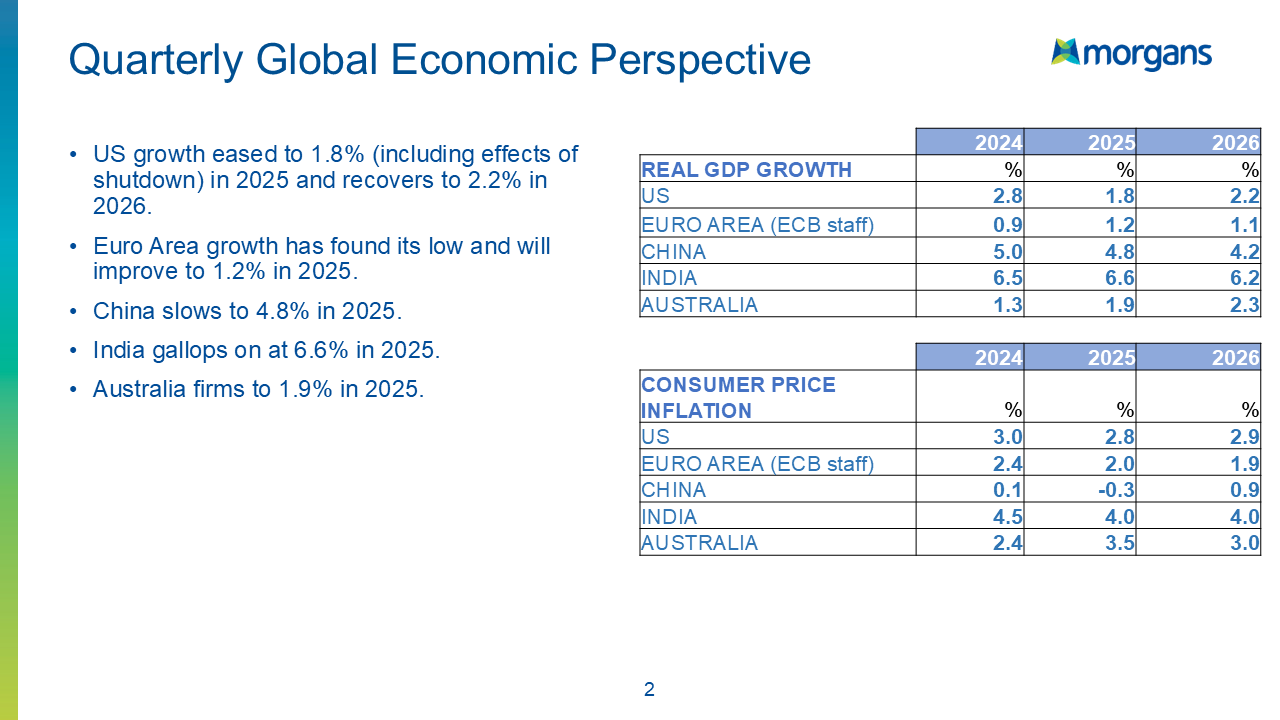
Australia: Inflation & Employment
- Retail electricity prices are rising as subsidies end, adding pressure to inflation.
- Employment growth is soft at 1.5%, below the median of 2.17%.
- Unemployment near 4% suggests inflation around 3.4%, above the RBA target.

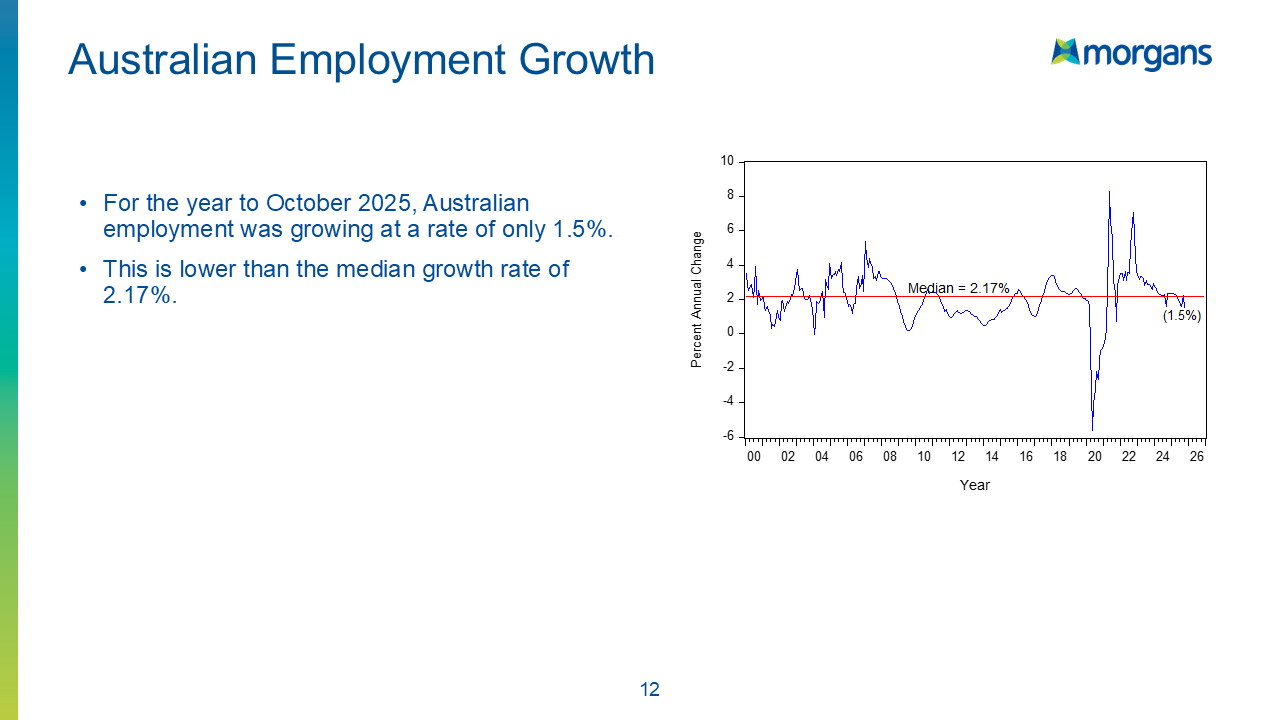
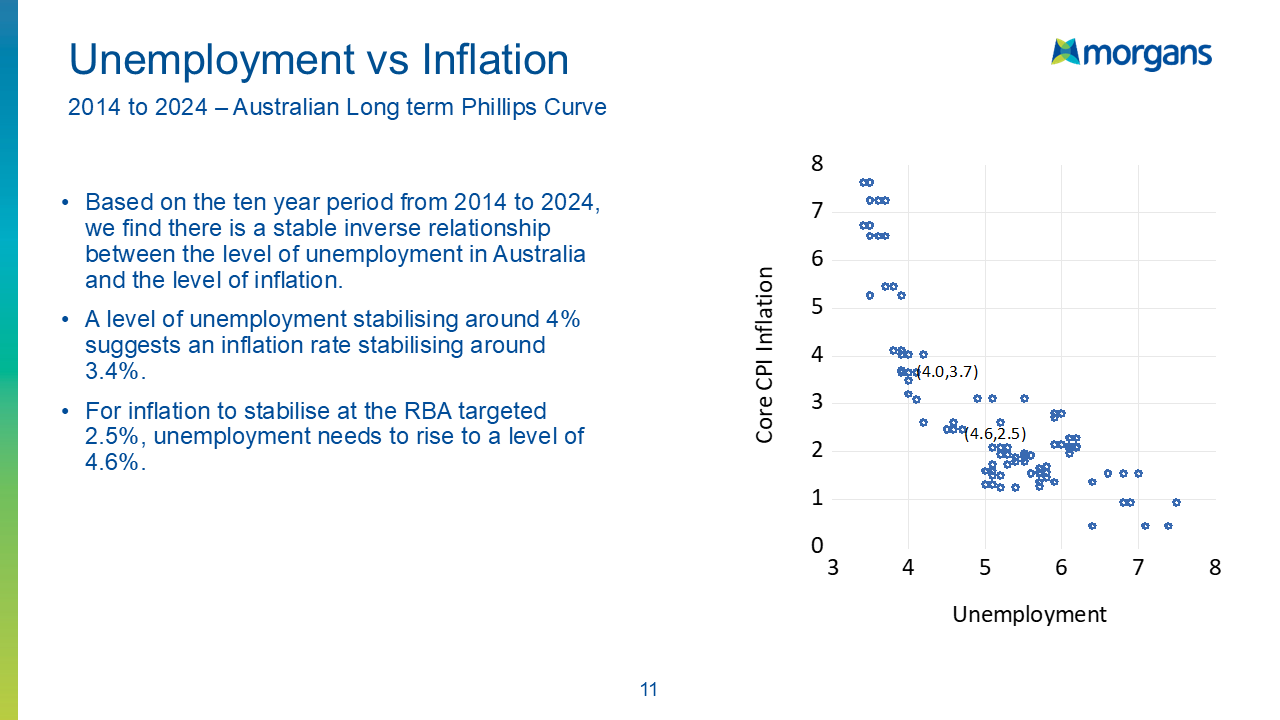
Interest Rates & Monetary Policy
- RBA cash rate expected to rise to 4.1%, driven by higher core inflation.
- In the US, below-trend growth signals potential Fed Funds rate cuts ahead.
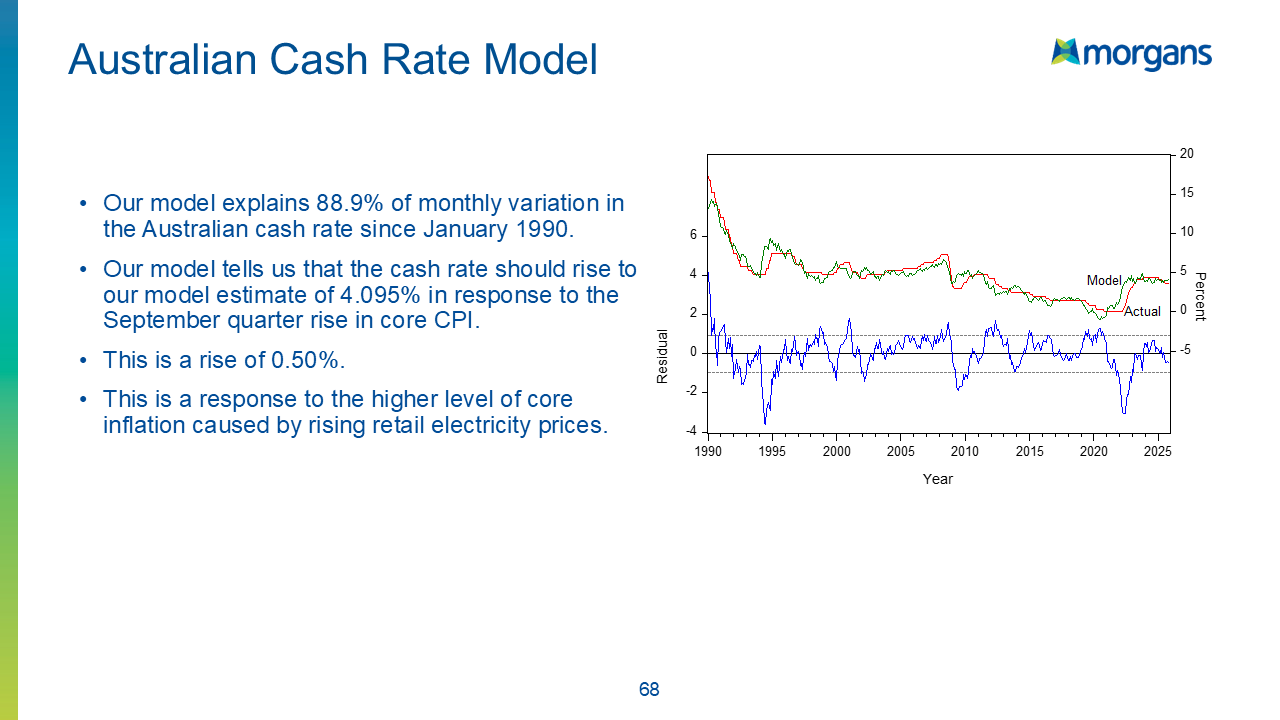
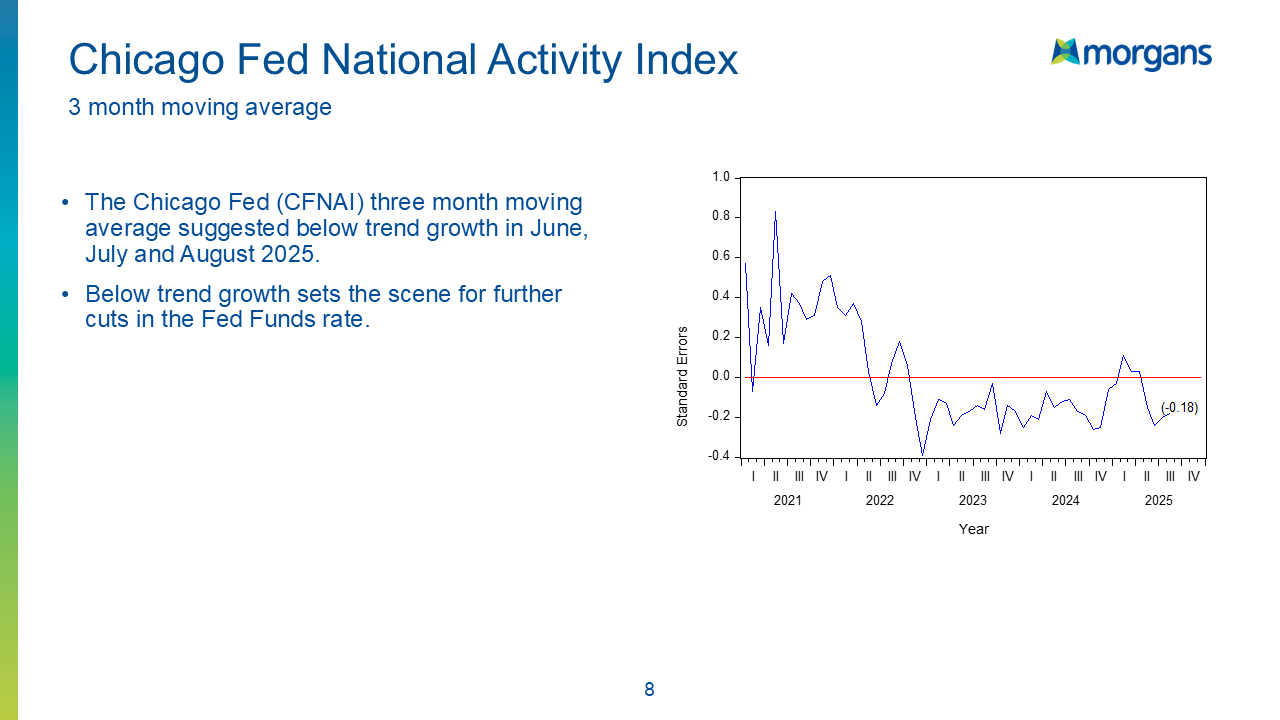
Commodities Snapshot
- Iron Ore: Slightly above fair value at US$100.80.
- Copper: Significantly overvalued at US$10,225 per tonne.
- Nickel & Zinc: Moderately undervalued.
- Gold: At record highs (US$4,013 per ounce) with limited upside.
- Soft Commodities: Wheat and cotton remain undervalued, presenting potential buying opportunities.
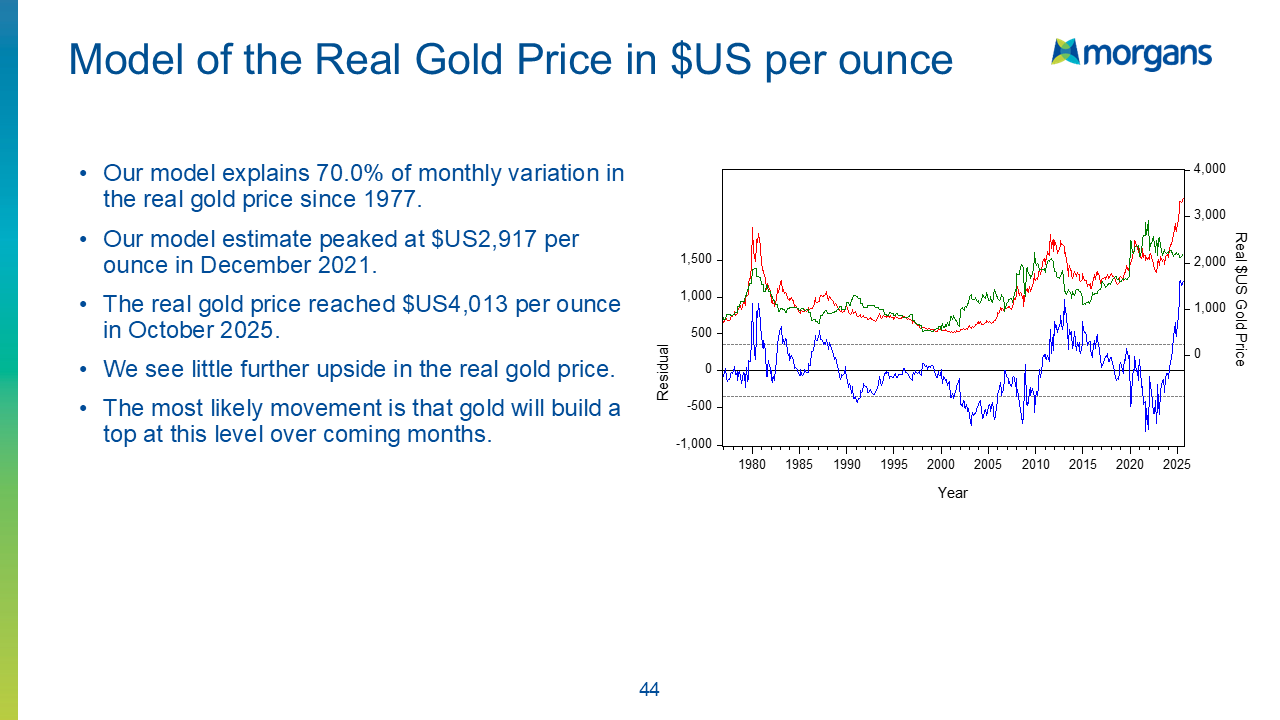
Equities Outlook
- S&P500: Model suggests fair value above current levels, but earnings expected to ease in Q4.
- ASX200: Trading well above model estimates, indicating strong sentiment.
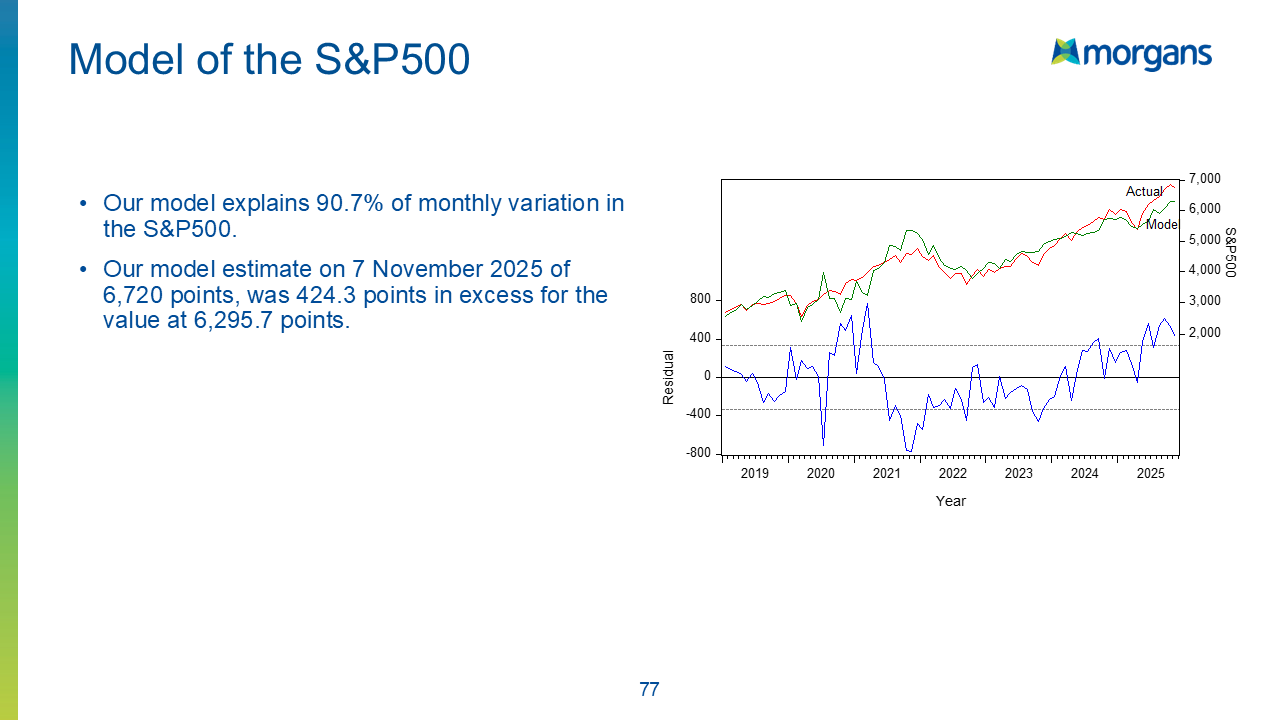
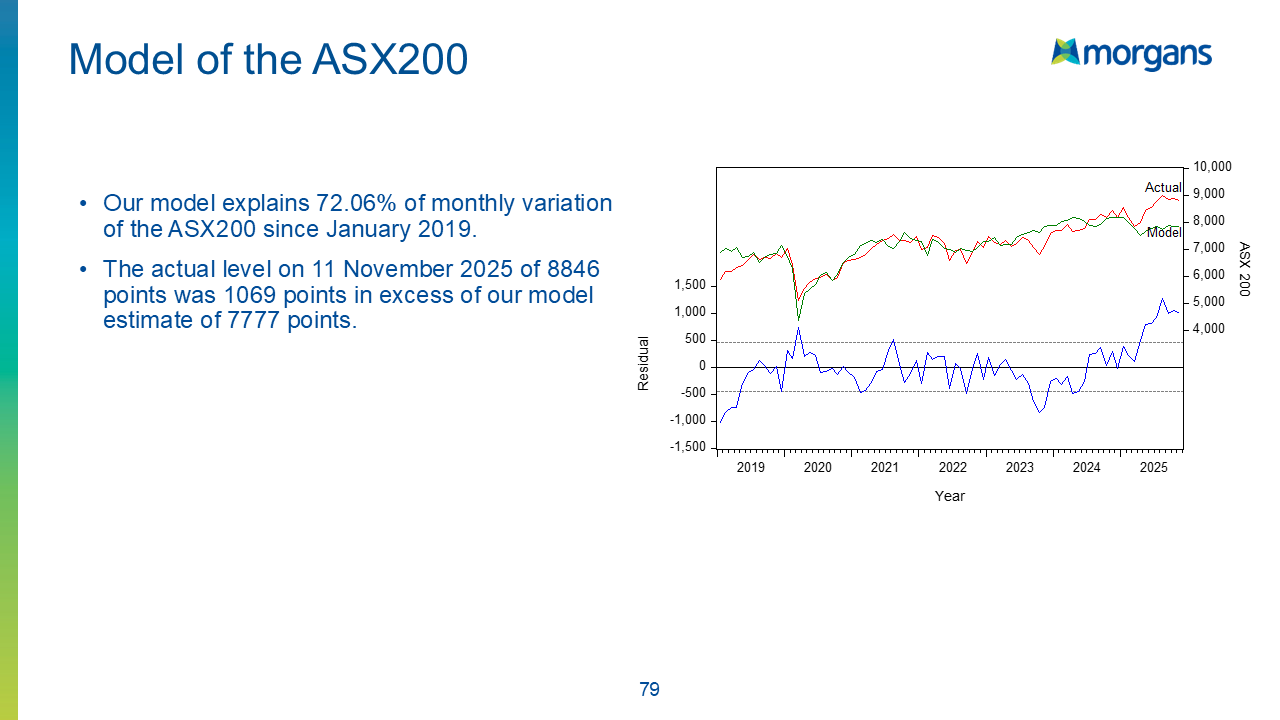
Currency & Bonds
- AUD/USD: Model estimate at US70.94 cents, above current level of US65.48 cents.
- US and German bonds appear moderately overvalued, reflecting strong foreign buying.
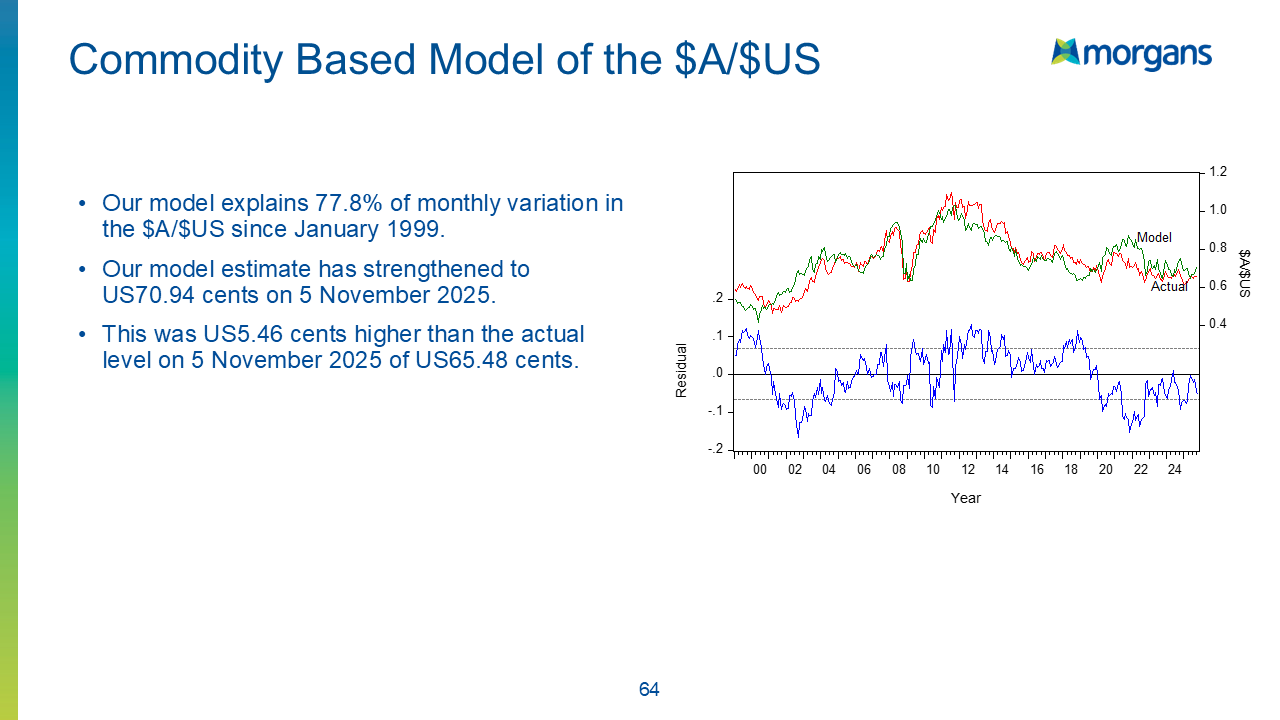
Closing Thoughts
Global growth is slowing, but commodity markets and equities show mixed signals. Inflation pressures in Australia suggest further rate hikes, while US policy may ease. Investors should watch undervalued opportunities in soft commodities and monitor interest rate trends closely.
FAQs
1. What is the outlook for global economic growth in 2025?
Global growth is slowing but stabilising. The US is expected to grow at 1.8%, the Euro Area at 1.2%, China at 4.8%, India at 6.6%, and Australia at 1.9%.
2. Why is Australian inflation expected to remain high?
Inflation pressures are driven by rising retail electricity prices as subsidies end, combined with relatively strong demand and employment trends.
3. Will the Reserve Bank of Australia raise interest rates?
Yes, the RBA cash rate is forecast to rise to around 4.1% in response to higher core inflation.
4. Which commodities are currently undervalued?
Soft commodities like wheat and cotton are significantly undervalued, while iron ore is near fair value and copper remains overvalued.
5. How are equity markets positioned heading into 2026?
The S&P500 is trading below model estimates, suggesting potential upside, while the ASX200 is above fair value, reflecting strong investor sentiment.
DISCLAIMER: Information is of a general nature only. Before making any financial decisions, you should consult with an experienced professional to obtain advice specific to your circumstances.









